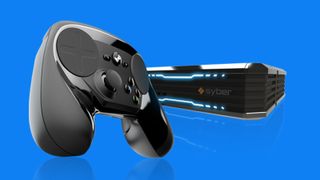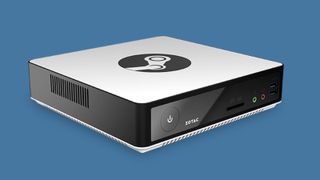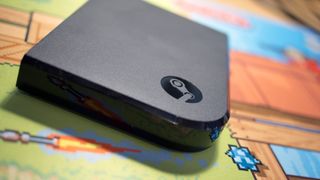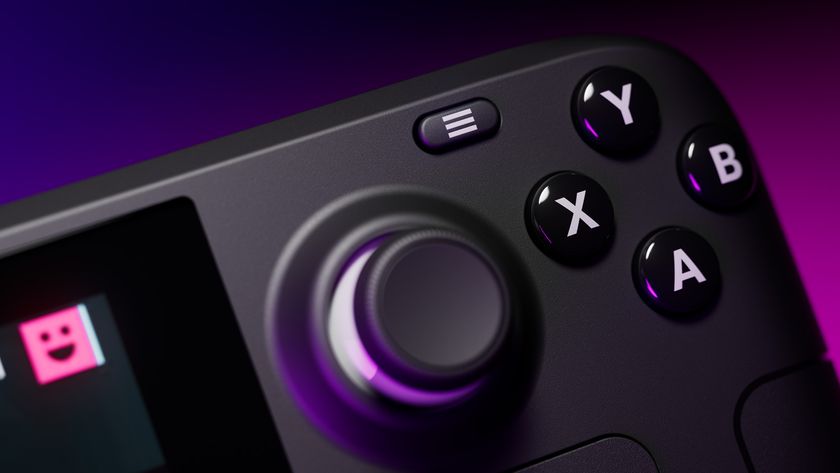Steam Machines: Valve's PC-like game consoles explained
What are Steam Machines, and how do they work?

Update: While Valve has remained mum on its Steam Machine plans, Microsoft seems to be taking influence and applying the Steam Machine principle more viably.
Original article continues...
When most people think of PC gaming the first thing that probably comes to mind is a keyboard, mouse and a monitor neatly arranged on a desk. But the days when PC gamers were confined to an office-like setting, perched numbly inches from their monitors are over. And now, with the rise of living-room centric VR platforms, there’s never been a better time to move away from that antiquated stereotype.
That’s where the Steam Machine thrives – a lineup of hardware from a wide range of manufacturers with a common goal: PCs that are designed for shared spaces, with a big-screen TV as the hub for all of it.
What's more, every single one of them runs an operating system based entirely on the Steam client, an application that since 2003 has provided a succinct catalog of computer games all capable of being stored locally in the same directory. Think of it as the iTunes of gaming, or even Spotify (minus the whole streaming-without-ties functionality). Steam, which started off on Windows, now packs considerable market share on both Mac and Linux as well.
The Steam Machine has a singular goal: make PC gaming in the living room more attainable for everyone. This is a continuation of a objective that Valve targeted years ago with their “Big Picture Mode” that was designed to be used from up to 10 feet away.
Try to think of Steam Machines not as a single device, but a wide range of mini-PCs licensed by – but not designed – by Valve, the gigantic company that created Steam. Every single Steam Machine is offered by an OEM partner like Dell, Origin or Syber, paired with Valve’s own Linus distro – SteamOS. They truly let you enjoy the Steam gaming experience in one easily accessible box.
Get daily insight, inspiration and deals in your inbox
Sign up for breaking news, reviews, opinion, top tech deals, and more.
Does the Steam Machine deliver on Valve’s promises? Let’s find out.
Cut to the chase
- What are they? Home theater-ready gaming PCs with Valve's SteamOS loaded
- When are they out? You can buy one now from various gaming PC makers
- How much do they cost? They generally start at $449 (about £311)
Valve already took a big step into the living room with Steam's Big Picture mode years ago, but that still required a desktop PC in your entertainment center – or a really long HDMI cable. Perhaps because of that, a lot of Valve's phrasing regarding SteamOS treats Steam (the service) and the new OS interchangeably.

Still, Valve's goals with Steam Machines and SteamOS are clear: bestow upon PC gaming the ease and accessibility that console jockeys already enjoy – in a way that lets PC hardware makers continue to compete.
And that puts Steam right at the center of it all, ready to vacuum up its cut of games sold on Steam Machines like it's the Steam summer sale all year long.
- Read more: SteamOS: what you need to know
The journey from announcement to launch has been long and a tad messy. But, at GDC 2015, Valve revealed the final details of its living room plans, which included Machines, the revised controller and its Vive virtual reality headset. Since then, a few smaller events and announcements kept things going into the 2015 holiday launch and beyond.
Losing steam already, but gaining influence
The journey from announcement to launch has been long and a tad messy. But, at GDC 2015, Valve revealed the final details of its living room plans, which included Machines, the revised controller and its Vive virtual reality headset. Since then, a few smaller events and announcements kept things going into the 2015 holiday launch and beyond.
After a false start or two, Valve went on to finally launch its Steam Machines back in November 2015 to little fanfare. While 15 Steam Machines were slated to launch by the end of 2015, only a handful actually made it out the door.

Some hardware, like the Digital Storm Eclipse and the Webhallen S15-01 Steam Machines, is still being held back by manufacturers, with the Steam website continuing to characterize them as "Coming Soon" despite a notable lack of concrete release information.
Falcon Northwest, on the other hand, decided to contest the SteamOS platform as a whole last year after being swarmed with technical issues, according to VentureBeat. The company later clarified to Digital Trends that the one hard drive limit in SteamOS made it harder to save on the high cost of solid-state storage.
Each of these Steam Machines are essentially gaming PCs inside home theater-friendly cases that run on the Linux-based SteamOS and come with one Steam Controller. Unfortunately, it's even more difficult to peg which box is best for the kind of games that you want to play, as they all offer multiple configurations.
In the few reviews of Steam Machine candidates that we've published, we have run up against the same conundrum: do Steam Machines really make PC gaming that much simpler?
It seems as if we're not alone in asking these questions, as PC World reports that a scant 1% of Steam users play their games on Linux or SteamOS. It doesn't help Valve's case that many of the Steam Machines available on the market are also offered in Windows 10 configurations, the generally-accepted default operating system for most PC gamers.
Despite their arguably low tangible impact, Steam Machines may be affecting the gaming industry by their very presence. For instance, rumors of an iterative (but arguably major) hardware upgrade for the PS4, known as the PS4K, have been circling the internet.
Before Steam Machines, such rumors were few and far in between and gained little to no traction, as such an upgrade was practically implausible for how it would disrupt the console cycle. But maybe – just maybe – console makers are feeling the heat to keep up with emerging gaming technologies that, say, Steam Machines and PCs can weather easily.

Who are Steam Machines for?
The easiest way to answer this one is to say "console gamers that have been put off by the complexity and prohibitive hardware pricing of PC gaming." However, while that may be the case, that hasn't turned out to be the result so far.
Console gamers might find Steam Machines far easier to set up than gaming PCs, but that still doesn't solve the problem that PC games are often developed for a wide range of hardware. Sometimes, PC game makers want to develop for the highest-end systems, which most Steam Machines certainly aren't.
This causes problems that you can probably already foresee. For instance, what if someone who bought a Steam Machine for the next big Fallout game release? She will still have to see whether the parts inside her Steam Machine can run the game well, much less whether Valve's proprietary SteamOS is even supported by the game. That's not at all how consoles work.
Read our hands on SteamOS review
So, when you ask who Steam Machines are for, it's almost easier to answer who they aren't for, and that's discerning hardcore gamers. Folks in this category can either put up with complexity for the sake of a great gaming experience on PC or know enough to avoid it altogether with a console.

For those who haven't been following along, here are all of the Steam Machines we know about and their release status:
List of Steam Machines available
- Syber Steam Machine (SteamOS) - from $499 (£499, about AU$679)
- Zotac NEN Steam Machine (SteamOS) - from $799 (£839, AU$1,087)
- Maingear Drift (Windows 10, SteamOS) - from $1,099 (about £759, AU$1,496)
- Materiel.net Steam Machine (SteamOS) - from about $906 (about £626, AU$1,232
- Scan 3XS ST Steam Machine (SteamOS) - from about $718 (£496, about AU$977)
- Alienware Alpha (Windows 10) - from $449 (£449, about AU$610)
- Origin Omega (Windows 10) - from $1,362 (about £942, AU$1,847)
List of Steam Machines unavailable
- Asus GR8S (discontinued)
- iBuyPower SBX (discontinued)
- Digital Storm Eclipse Steam Machine (coming soon)
- Alternate Steam Machine (coming soon)
- Webhallen S15-01 (coming soon)
- Next Spa NextBox (coming soon)
- Gigabyte Brix Pro (cancelled)
- Falcon Northwest Tiki (cancelled)

The silver lining: Steam Controller and Steam Link
Every Steam Machine comes packaged with what might be the best product of Valve's big coup for the living room, the Steam Controller. Sold separately for a discounted price of $35 (£28), the Steam Controller primarily uses haptic feedback touchpads for input, a first for modern PC gaming.
The controller is affordable, beautifully designed and infinitely customizable. In fact, Steam now offers a fully-fledged community of Steam users that share uploadable controller profiles that can change everything from button mapping to the intensity of the haptic feedback motors.
Furthermore, in June, Valve updated the Steam Controller with a plethora of new features in commemoration of its 500,000 units sold.
Unlike before, motion controls could be used for racing games in addition to the controller receiving game-specific control scheme configurations. And, on an exciting note for HTC Vive users, the hardware gained support for SteamVR's Desktop Theater Mode.
Unfortunately for Valve, what's being celebrated as its shining achievement indicates bad news for its platform on the whole. 500,000 controllers sold might sound like a high point for the company, but considering every Steam Machine was bundled with one, it's now evident that less than half a million consoles were sold in over seven months.
Then there's the Steam Link, which doesn't solve the problem that Valve claims to be tackling with Steam Machines, but does one better. Like the Steam Controller, Valve's set-top box was discounted to $35 (£28) on June 2 and lets you stream games played on your PC via Steam to whatever HDTV the Link is connected to.
Streaming happens over your local network, and essentially allows you to play PC games in front of your TV without the need for a complicated HDMI setup or other methods. Steam Machines running on SteamOS offer this capability too. But why spend 500-plus dollars for that feature when you can spend just 35?

Where do Steam Machines go from here?
The exact future of Valve's living room project is largely unknown, as there hasn't been much said of future Steam Machine releases from neither their creator nor its partners. At this rate, Steam Link has a better chance of fulfilling Valve's couch-ridden dreams than any Steam Machine does.
With GDC 2016 having came and went with nary a word on Steam Machines, it would seem that Valve is in a holding pattern with the project. However, the firm struck up a deal with Lionsgate in April to stream about 100 films from its catalog on a rental basis, a la Amazon Prime Instant Video.
Then, in June, Dell revealed alongside some other hardware updates that it would be releasing a $749 Alienware Steam Machine equipped with an i5 Skylake processor, a GTX 960 GPU, 500GB of storage space and 8GB of RAM, though buyers could opt for an i7 and a 1TB hard drive for $100 more. Alienware senior marketing manager Chris Sutphen told ITWorld that the company "[expects] the SteamOS catalog to strengthen at the end of the year."
With E3 out of the way, Microsoft seems to be undertaking a similar strategy in unifying its PC and console platforms and adding two new tiers to its Xbox One hardware lineup. Redmond, however, wants to make its games playable across all of its hardware, differentiating it from Valve's initial plans with the Steam Machines.
Valve may be making an effort to get SteamVR working with lower-power graphics cards, but with Microsoft's plans to bring Xbox games to Steam for Windows 10, Valve's ambitious living room computers may be dead in the water. SteamOS, on the other hand, is a different story.
- As it turns out, Windows 10 is good for PC gamers
Alex Roth and Gabe Carey also contributed to this article
Joe Osborne is the Senior Technology Editor at Insider Inc. His role is to leads the technology coverage team for the Business Insider Shopping team, facilitating expert reviews, comprehensive buying guides, snap deals news and more. Previously, Joe was TechRadar's US computing editor, leading reviews of everything from gaming PCs to internal components and accessories. In his spare time, Joe is a renowned Dungeons and Dragons dungeon master – and arguably the nicest man in tech.

Can’t buy an Nvidia RTX 5080 or 5090 GPU due to stock shortages? If you were hoping GeForce Now might provide a good alternative, we’ve got some bad news

Steam Deck fans, you're in for a good one - AMD's FSR 3 frame generation is now available on Valve's handheld thanks to a new Decky plugin
Most Popular




